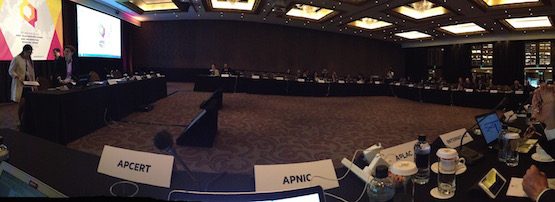
In September 2010, the APEC Telecommunications and Information Working Group (TEL) endorsed a set of guidelines to ‘support the deployment of Internet Protocol version 6 (IPv6)’. Today, the stats from APNIC Labs, and analysis by APNIC’s Miwa Fujii, show some encouraging signs across the APEC region, with the United States (26.5%), Peru (15.5%), Japan (15.7%), Malaysia (10.2%) and Singapore (9.6%) all among the top 15 economies for IPv6 end-user adoption. Reflecting back on the guidelines at the recent APEC TEL 52 meeting, it is clear that not only have they aged remarkably well, but more importantly, they can be seen echoed in the policies of APEC economies.
The five-year old APEC TEL IPv6 Guidelines set out straightforward initiatives that policymakers and regulators can follow to support deployment. Covering planning, technical management, capacity development, government cooperation, leading by example, and public-private partnerships, the guidelines offer pragmatic options such as the development of deployment plans, building an IPv6 skills base, information exchange, and the sharing of best practices.
Leading by example is also an important principle that governments can tackle head on. It creates a baseline ‘bootstrap demand’ for IPv6 in an economy and provides a proving ground where lessons learned can be shared with industry. The government in Chinese Taipei is pursuing this approach with vigour, aiming to deploy IPv6 in all of its external facing systems by the end of the year and completing deployment in all internal systems during 2016. Singapore’s Infocomm Development Agency (IDA) is also advancing IPv6 deployment in its network.
While far from the top 15 at 0.7% IPv6 adoption, the Republic of Korea represents a more recent embodiment of another guideline category: partnership between governments and industry. A year after enabling 464XLAT transition technology in their LTE mobile networks, SK Telecom has seen a sharp increase in IPv6 adoption, reaching 18.8%. To put the numbers in perspective, T-Mobile in the US used a similar method in 2013 and is now showing IPv6 adoption at 72.5%. As SK Telecom’s Deoknyong Ko explained at APNIC 40, the South Korean government is actively encouraging ISPs and content providers to enable IPv6 in their networks, demonstrating how effective collaboration between the public and private sectors can help lay the groundwork for successful IPv6 deployment.
Globally, IPv6 adoption has seen a 100% increase in the last 12 months. Although this only represents 4.9% of total users there is reason to be optimistic about the overall trend. In order to register as IPv6 capable, a connection must be end-to-end IPv6. This requires end user devices, service providers, content providers, the operating systems, all pieces of the connection to be actively IPv6 enabled (or use IPv6 transition technology), an admittedly high barrier to measurement. To misappropriate some physics terminology, while the absolute (or kinetic) numbers behind IPv6 deployment may remain low, the numbers mask a much higher IPv6 ‘potential energy’.
Moreover, by nature of design, network operators seek compatibility. As more and more influential service providers opt for IPv6, adoption will spread to other network operators, enterprises, service and content providers. This can be seen in Japan where long-time IPv6 stalwarts, KDDI and CTC Chube Telecommunications, are now joined by mid-to-small sized and regional operators such as STCN STNet and Tokai Communications Corporation. Similarly across the region, an increasing number of cloud services and hosting companies are making a dent in the deployment charts.
APEC TEL reaffirmed its commitment to IPv6 deployment in its Strategic Action Plan 2016-2020 and with interest to explore the Internet of Things and Internet economy, IPv6 readiness will continue to play an important role in TEL activities. After all, IPv6 deployment is not simply about the technical requirements, but about using the technology to ensure the Internet can continue to grow and to be a catalyst for innovation and foundation for sustainable economic growth and prosperity. And that falls squarely into APEC’s mission.
The views expressed by the authors of this blog are their own and do not necessarily reflect the views of APNIC. Please note a Code of Conduct applies to this blog.
